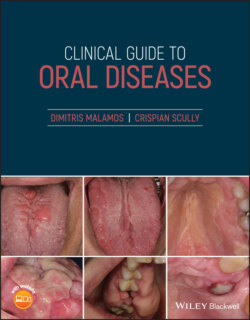Читать книгу Clinical Guide to Oral Diseases - Crispian Scully - Страница 21
Case 1.7
ОглавлениеFigure 1.7
CO: A 36‐year‐old woman was presented with hemorrhage from her tongue.
HPC: Her tongue bleeding appeared one month ago when she gave birth to a baby girl. The bleeding had arisen from a superficial strawberry‐like soft mass on the dorsum and inferior part of her tongue while it deteriorated with mastication movements.
PMH: Her medical history revealed no serious diseases such as bleeding disorders. A case of iron deficiency anemia was only recorded since puberty which was treated with iron supplements as well as a few tongue surgeries for the elimination of a vascular lesion of her tongue in the past. The patient was not a supporter of smoking or drinking habits, while she used to spend her free time painting.
OE. The oral examination revealed multiple small hemorrhagic dots on the dorsum and inferior part of tongue (Figure 1.7) which were similar to a mature strawberry. These dots are superficial and could easily bleed with touching, and were overlying a soft vascular mass. This mass was detected when she was one year old, and became larger during puberty, requiring surgery. It remained stable until her pregnancy when it became bigger and was occasionally bleeding. No other similar lesions, petechiae, or ecchymoses were found on her body.
Q1 What is the cause of bleeding?
1 Hemangioma
2 Vascular malformation
3 Kaposi sarcoma
4 Pregnancy pyogenic granuloma
5 Wegener granulomatosis
Answers:
1 No
2 Vascular malformations are characterized by abnormalities of the capillary, venous or arterio‐venous vascular bed which appear at birth or a few months later, and grow gradually. Contrary to other vascular lesions though, they do not resolve; instead they can be exacerbated with various conditions such as pregnancy.
3 No
4 No
5 No
Comments: Based on the early onset and long duration of this single lesion,without resolution throughout the coming years hemangiomas are easily excluded while the long duration and slow progress without other similar lesions in patient’s body or general symptomatolog rules out extensive pyogenic grannulomas or Wegener granulomatatosis from the diagnosis.
Q2 What are the differences between hemangiomas and vascular malformations?
1 Location
2 Course
3 Symptomatology
4 Pathogenesis
5 Complications
Answers:
1 No
2 Hemangiomas appear mostly at birth, grow rapidly and resolve during puberty while vascular malformation remain or even worsen.
3 No
4 Hemangiomas are characterized by endothelial hyperplasia while in vascular malformations the endothelial cell turnover is normal.
5 Both hemangiomas and vascular malformations cause a variety of complications from mild esthetic disfiguration to severe possibility of jeopardizing the patient's life dependent on the size and location of the lesion closely to vital organs.
Q3 Which of the syndromes below is/or are not associated with this condition?
1 Sturge‐Weber syndrome
2 PHACE syndrome
3 Proteus syndrome
4 Maffucci syndrome
5 Blue rubber bleb nevus syndrome (BRBNS)
Answers:
1 No
2 PHACE syndrome is characterized by multi‐organ lesions such as posterior fossa anomalies; facial hemangiomas, arterial and cardiac anomalies as well as eye problems
3 No
4 No
5 No
Comments: Abnormal vascular malformations are often seen in a number of syndromes like Sturge‐Weber; Maffucci, Proteus and blue rubber belb but all of them have different clinical presentation. Sturge‐Weber syndrome is characterized by numerous facial (port‐wine stain) and cerebral angiomas, glaucoma, seizures and mental retardation while in Maffucci syndrome, angioma is associated with numerous endochondromas. Proteus syndrome has characteristic skin, bone, muscle and vascular abnormal growths, while venous malformations of the gastrointestinal tract and skin are seen in blue rubber bleb nevus syndrome.
